This article has been
cited by other articles in ScienceCentral.
Abstract
Background
Bibliometrics is increasingly used to assess the quantity and quality of scientific research output in many research fields worldwide. This study aims to update Korea's worldwide research productivity in the field of orthopedics using bibliometric methods and to provide Korean surgeons and researchers with insights into such research.
Methods
Articles published in the top 15 orthopedic journals between 2008 and 2017 were retrieved using the Web of Science. The number of articles, citations and h-index (Hirsch index), funding sources, institutions, and journal patterns were analyzed.
Results
Of the total 39,494 articles, Korea's contribution accounted for 5.6% (2,161 articles), ranking fifth in the world in the number of publications. Korea ranked sixth (with 29,456) for total citations worldwide but ranked 17th (13.64) in terms of average citation per item and 14th (55) in terms of h-index. Korea showed the most prolific productivity in the field of sports medicine and arthroscopy. The institution that produced the highest number of publications was Seoul National University (n = 386, 17.9%).
Conclusions
Orthopedic research in South Korea demonstrated high productivity in terms of the number of publications in high-quality journals between 2008 and 2017. However, total citations and average citations per article were still relatively low. Efforts should be made to increase citation rates for further improvement in research productivity in the field of orthopedics.
Keywords: Bibliometrics, Research, Orthopedics, Journal Impact Factor, Korea
Recently, a number of studies on publication activities have been conducted to evaluate the research output of different countries in the field of orthopedics.
123) These recent studies used bibliometric methods to investigate trends in scholarly publications and perform quantitative and qualitative analysis of academic literature. Previous studies provided rankings of countries by publications in major orthopedic journals, where Korea's contribution has dramatically increased.
123456)
Although the number of publications is a simple indicator of scientific research productivity, it is no longer sufficient as a measure of academic productivity of various nations. Although academic activities in the field of orthopedics were addressed in a bibliometric study in Korea, it is flawed in that it does not depict the combined information of papers with their relevant citations.
4) In addition, orthopedic articles are published in many types of journals, but not all of these are reputable or of high quality. To explore the impact of an author or a set of institutions within their field, the credibility of the source should also be verified.
7)
Thus, we performed this study using the 15 highest-rated orthopedic journals based on the 2017 impact fator. The aim of this study was to investigate the research productivity and contribution of Korean authors affiliated with orthopedic departments using both quantitative and qualitative bibliometric analysis.c
METHODS
Search and Data Selection
The 2017 Journal Citation Report was accessed on the Web of Science (WOS; Thomson Reuters, New York, NY, USA), and the 15 highest-ranked journals based on their 2017 impact factor were selected from the orthopedics category (
Table 1). Journals focusing on spinal issues were excluded so that authors from other specialties, especially neurosurgery, would not be included. Because the British Journal of Bone and Joint Surgery became the Bone Joint Journal in 2013, articles from these two journals were pooled together in this study.
Table 1
Top 15 Orthopedic Journals Based on Impact Factor (2017 Journal Citation Reports, Clarivate Analytics) from 2008 to 2017
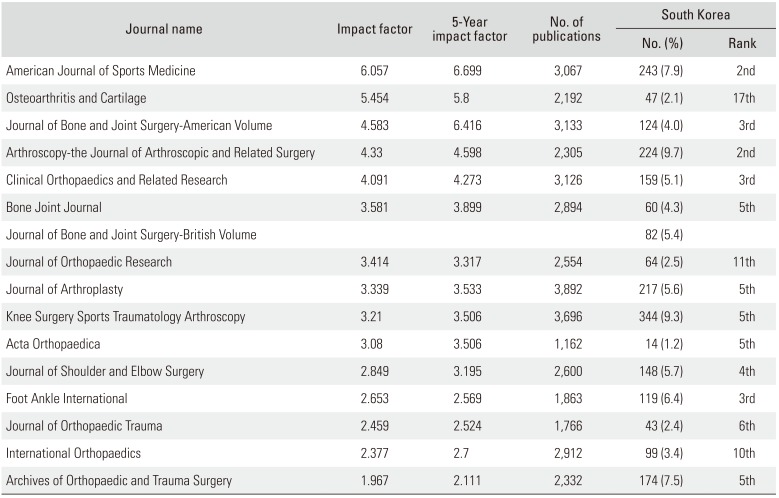
|
Journal name |
Impact factor |
5-Year impact factor |
No. of publications |
South Korea |
|
No. (%) |
Rank |
|
Americanz Journal of Sports Medicine |
6.057 |
6.699 |
3,067 |
243 (7.9) |
2nd |
|
Osteoarthritis and Cartilage |
5.454 |
5.8 |
2,192 |
47 (2.1) |
17th |
|
Journal of Bone and Joint Surgery-American Volume |
4.583 |
6.416 |
3,133 |
124 (4.0) |
3rd |
|
Arthroscopy-the Journal of Arthroscopic and Related Surgery |
4.33 |
4.598 |
2,305 |
224 (9.7) |
2nd |
|
Clinical Orthopaedics and Related Research |
4.091 |
4.273 |
3,126 |
159 (5.1) |
3rd |
|
Bone Joint Journal |
3.581 |
3.899 |
2,894 |
60 (4.3) |
5th |
|
Journal of Bone and Joint Surgery-British Volume |
|
|
|
82 (5.4) |
|
|
Journal of Orthopaedic Research |
3.414 |
3.317 |
2,554 |
64 (2.5) |
11th |
|
Journal of Arthroplasty |
3.339 |
3.533 |
3,892 |
217 (5.6) |
5th |
|
Knee Surgery Sports Traumatology Arthroscopy |
3.21 |
3.506 |
3,696 |
344 (9.3) |
5th |
|
Acta Orthopaedica |
3.08 |
3.506 |
1,162 |
14 (1.2) |
5th |
|
Journal of Shoulder and Elbow Surgery |
2.849 |
3.195 |
2,600 |
148 (5.7) |
4th |
|
Foot Ankle International |
2.653 |
2.569 |
1,863 |
119 (6.4) |
3rd |
|
Journal of Orthopaedic Trauma |
2.459 |
2.524 |
1,766 |
43 (2.4) |
6th |
|
International Orthopaedics |
2.377 |
2.7 |
2,912 |
99 (3.4) |
10th |
|
Archives of Orthopaedic and Trauma Surgery |
1.967 |
2.111 |
2,332 |
174 (7.5) |
5th |

On September 27, 2018, a computerized literature search of the WOS database was conducted. The WOS includes the Science Citation Index Expanded (SCIE) and has been traditionally the major source of citation data. There was no restriction on language and only original articles and reviews were included. When more than one institutional affiliation was listed, the country of the corresponding author was taken as the source nation.
All orthopedic articles published between January 2008 and December 2017 were retrieved from the WOS using the search terms (
Supplementary Fig. 1). A total of 52,792 orthopedic articles published between January 2008 and December 2017 were identified. Of those, 13,298 articles were excluded for the following reasons: meeting abstract (n = 5,738), editorial (n = 3,300), letter (n = 2,220), proceeding paper (n = 1,258), corrigendum (n = 538), biographical item (n = 152), reprint (n = 70), and other items (n = 22). Finally, 39,494 articles were included in this study.
Outcomes
The primary outcome was the number of original articles attributed to each country. Countries were then ranked according to their productivity expressed by the number of publications. The total number of publications and the total impact factor per country were collated. In addition, the number of publications adjusted by gross domestic product (GDP), number of funded studies, and the proportion of contributions of countries in each journal were obtained.
We also examined the total citations, average citations per item, and h-index (Hirsch index). The h-index is an author-level metric that attempts to measure both the productivity and citation impact of the publications of a scientist or scholar; an author has index h if his or her number of papers have at least h citations.
8) Total citations, average citations per item, and h-index were extracted from the WOS citation report. Finally, publications according to institutions were assessed.
Statistical Analysis
This study did not include any hypothesis testing. Because our goal was to describe trends, not to test hypotheses about the relative contribution of different countries, only simple descriptive statistics were used. This study was exempted from review of institutional review board since it did not involve any human subjects.
RESULTS
Total Number
There was a significant increase in the worldwide number of annually published orthopedic articles from 2008 through 2017 (
Fig. 1). The United States was consistently the most productive country with a total of 16,747 published orthopedic articles. Overall, the top five countries were the United States, Germany, United Kingdom, Japan, and South Korea; these countries were together responsible for 69.5% of all publications (
Table 2).
Fig. 1
Time trend for total number of articles from top five countries between 2008 and 2017.
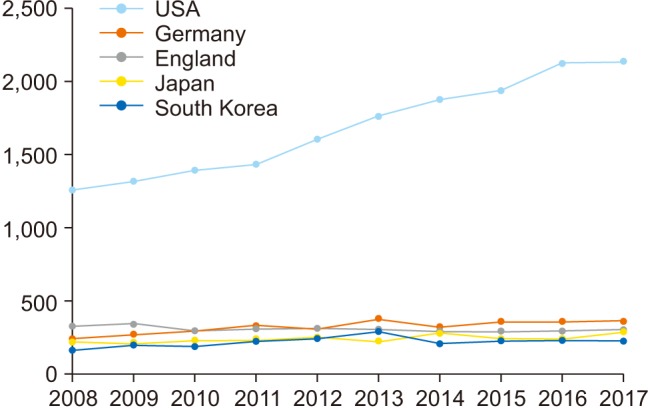

Table 2
Top 20 Countries According to the Number of Publications
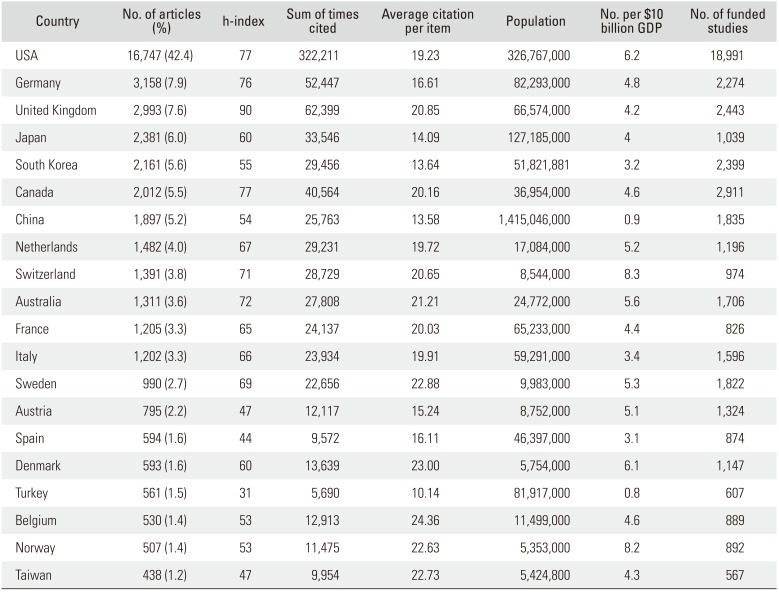
|
Country |
No. of articles (%) |
h-index |
Sum of times cited |
Average citation per item |
Population |
No. per $10 billion GDP |
No. of funded studies |
|
USA |
16,747 (42.4) |
77 |
322,211 |
19.23 |
326,767,000 |
6.2 |
18,991 |
|
Germany |
3,158 (7.9) |
76 |
52,447 |
16.61 |
82,293,000 |
4.8 |
2,274 |
|
United Kingdom |
2,993 (7.6) |
90 |
62,399 |
20.85 |
66,574,000 |
4.2 |
2,443 |
|
Japan |
2,381 (6.0) |
60 |
33,546 |
14.09 |
127,185,000 |
4 |
1,039 |
|
South Korea |
2,161 (5.6) |
55 |
29,456 |
13.64 |
51,821,881 |
3.2 |
2,399 |
|
Canada |
2,012 (5.5) |
77 |
40,564 |
20.16 |
36,954,000 |
4.6 |
2,911 |
|
China |
1,897 (5.2) |
54 |
25,763 |
13.58 |
1,415,046,000 |
0.9 |
1,835 |
|
Netherlands |
1,482 (4.0) |
67 |
29,231 |
19.72 |
17,084,000 |
5.2 |
1,196 |
|
Switzerland |
1,391 (3.8) |
71 |
28,729 |
20.65 |
8,544,000 |
8.3 |
974 |
|
Australia |
1,311 (3.6) |
72 |
27,808 |
21.21 |
24,772,000 |
5.6 |
1,706 |
|
France |
1,205 (3.3) |
65 |
24,137 |
20.03 |
65,233,000 |
4.4 |
826 |
|
Italy |
1,202 (3.3) |
66 |
23,934 |
19.91 |
59,291,000 |
3.4 |
1,596 |
|
Sweden |
990 (2.7) |
69 |
22,656 |
22.88 |
9,983,000 |
5.3 |
1,822 |
|
Austria |
795 (2.2) |
47 |
12,117 |
15.24 |
8,752,000 |
5.1 |
1,324 |
|
Spain |
594 (1.6) |
44 |
9,572 |
16.11 |
46,397,000 |
3.1 |
874 |
|
Denmark |
593 (1.6) |
60 |
13,639 |
23.00 |
5,754,000 |
6.1 |
1,147 |
|
Turkey |
561 (1.5) |
31 |
5,690 |
10.14 |
81,917,000 |
0.8 |
607 |
|
Belgium |
530 (1.4) |
53 |
12,913 |
24.36 |
11,499,000 |
4.6 |
889 |
|
Norway |
507 (1.4) |
53 |
11,475 |
22.63 |
5,353,000 |
8.2 |
892 |
|
Taiwan |
438 (1.2) |
47 |
9,954 |
22.73 |
5,424,800 |
4.3 |
567 |

Impact Factor, Citations of Published Articles, and h-Index Citations
On the analysis of total citations, US-authored articles were cited the highest number of times (322,211), followed by the United Kingdom (62,399), and Germany (52,447). Korea ranked sixth (with 29,456) in the world. However, the ranking of average citations per item differed quite markedly from the ranking based on the total citation. Belgium was the leading country with 24.36, followed by Denmark (23), Sweden (22.88), Taiwan (22.73), and Norway (22.63). Korea ranked 17th in the world with 13.64 (
Table 2). The United Kingdom (90) was in the first place according to h-index, followed by the United States (77), Canada (77), Germany (76), and Australia (72). Korea ranked 14th in the world with 55.
Prolific Institutions and Publications in Each Journal
A small number of institutions accounted for a large proportion of the total number of articles, similar to previous findings. Harvard, with 1,303 articles, topped this list and the United States had the greatest share of highly ranked institutions (nine of the top 10 institutions). Seoul National University was the most prolific institutional source of orthopedic articles in Korea with 386 publications and ranked 21st in terms of total publication number in the world. Korea University (259 publications, ranked 51st), Sungkyunkwan University (227 publications, ranked 70th), and Yonsei University (181 publications, ranked 92nd) were included in the top 100 institutions (
Table 3 and
Supplementary Table 1). In terms of contributions to individual journals, Korea ranked 2nd in the
American Journal of Sports Medicine and
Arthroscopy-the Journal of Arthroscopic and Related Surgery (
Table 1). Among 10 highly cited Korean original articles, nine were published in these two journals (
Table 4).
Table 3
Distribution by Institutions of Articles Published by Korea in Journals between 2008 and 2017
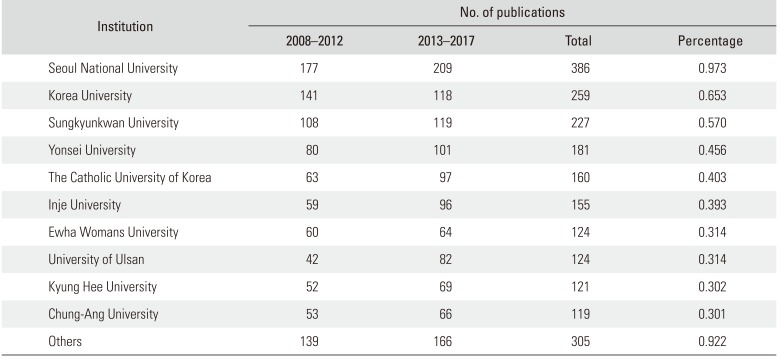
|
Institution |
No. of publications |
|
2008–2012 |
2013–2017 |
Total |
Percentage |
|
Seoul National University |
177 |
209 |
386 |
0.973 |
|
Korea University |
141 |
118 |
259 |
0.653 |
|
Sungkyunkwan University |
108 |
119 |
227 |
0.570 |
|
Yonsei University |
80 |
101 |
181 |
0.456 |
|
The Catholic University of Korea |
63 |
97 |
160 |
0.403 |
|
Inje University |
59 |
96 |
155 |
0.393 |
|
Ewha Womans University |
60 |
64 |
124 |
0.314 |
|
University of Ulsan |
42 |
82 |
124 |
0.314 |
|
Kyung Hee University |
52 |
69 |
121 |
0.302 |
|
Chung-Ang University |
53 |
66 |
119 |
0.301 |
|
Others |
139 |
166 |
305 |
0.922 |

Table 4
Top 10 Most Cited Korean Articles in Top 15 Orthopedic Journals from 2008 to 2017
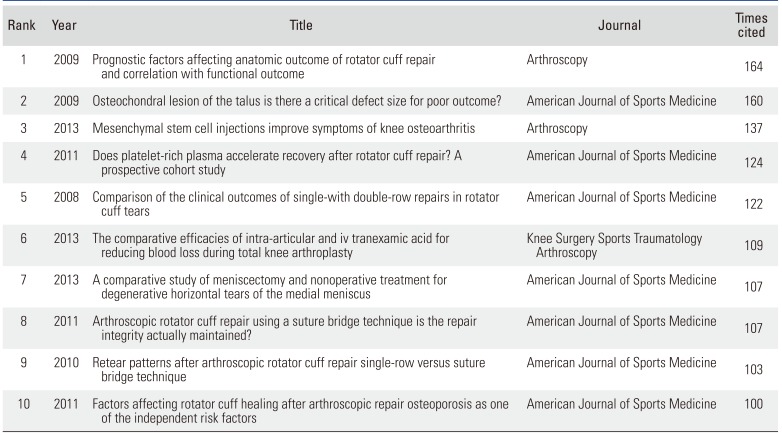
|
Rank |
Year |
Title |
Journal |
Times cited |
|
1 |
2009 |
Prognostic factors affecting anatomic outcome of rotator cuff repair and correlation with functional outcome |
Arthroscopy |
164 |
|
2 |
2009 |
Osteochondral lesion of the talus is there a critical defect size for poor outcome? |
American Journal of Sports Medicine |
160 |
|
3 |
2013 |
Mesenchymal stem cell injections improve symptoms of knee osteoarthritis |
Arthroscopy |
137 |
|
4 |
2011 |
Does platelet-rich plasma accelerate recovery after rotator cuff repair? A prospective cohort study |
American Journal of Sports Medicine |
124 |
|
5 |
2008 |
Comparison of the clinical outcomes of single-with double-row repairs in rotator cuff tears |
American Journal of Sports Medicine |
122 |
|
6 |
2013 |
The comparative efficacies of intra-articular and iv tranexamic acid for reducing blood loss during total knee arthroplasty |
Knee Surgery Sports Traumatology Arthroscopy |
109 |
|
7 |
2013 |
A comparative study of meniscectomy and nonoperative treatment for degenerative horizontal tears of the medial meniscus |
American Journal of Sports Medicine |
107 |
|
8 |
2011 |
Arthroscopic rotator cuff repair using a suture bridge technique is the repair integrity actually maintained? |
American Journal of Sports Medicine |
107 |
|
9 |
2010 |
Retear patterns after arthroscopic rotator cuff repair single-row versus suture bridge technique |
American Journal of Sports Medicine |
103 |
|
10 |
2011 |
Factors affecting rotator cuff healing after arthroscopic repair osteoporosis as one of the independent risk factors |
American Journal of Sports Medicine |
100 |

DISCUSSION
The increase in the number of high-quality research studies can be an indicator of rapid improvement in the country's level of education, service delivery, and shift from a production-based economy to a knowledge-based economy.
9) Orthopedic research has experienced a considerable evolution in Korea during the last 10 years, which can be attributed to contributions from researchers and medical practitioners.
23510) Research productivity does not reflect patient care, but the quality of clinical care patients receive today is built upon past research, and patients will continue to benefit from current research. Therefore, we all need to continue to pursue and learn from high-quality research.
Evidence-based medicine caused a quantitative expansion of scientific publications, and the number of orthopedic publications continues to expand consistently worldwide. Therefore, we only focused on the top 15 journals in the field of orthopedics. It appears that South Korea deserves to be recognized for its high productivity from the international community in terms of the number of total orthopedic publications, even though various perspectives were used in many previous reports.
12345611) The Korean orthopedic community has continuously attempted a number of different approaches to improve research performance by providing research awards, scholarships, and funding to motivate academic staff. The Korean government and various research institutions also foster international joint research and networking activities between researchers at the world's top universities and research institutes. Social network analysis displayed the co-authorship pattern of top 20 countries for orthopedic publications and six clusters of co-authorship collaboration were identified. The biggest cluster is led by the United States, followed by Germany, South Korea, and other Asian countries (
Fig. 2).
Fig. 2
Co-authorship network for orthopedic publications among top 20 countries from 2008 through 2017.
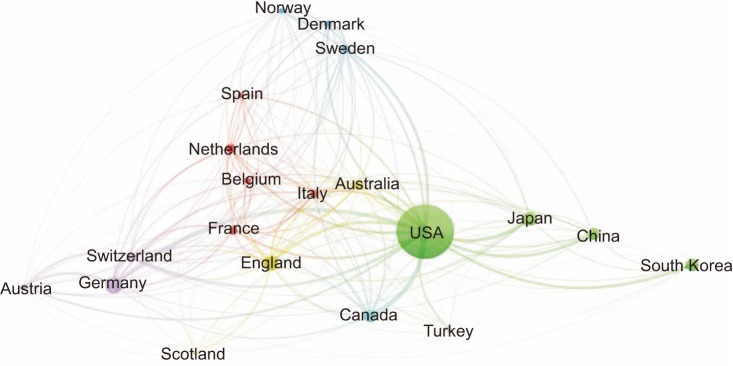

However, the citation performance of journals published in Korea remains low. In other words, many articles are published, but there are not many good articles attracting attention. The citation rate of an article can reflect the quality and value of the research it reports, and the h-index, which combines the number of citations and publications, can measure the productivity and impact of a group of scientists from a department, university, or country.
12) It should be noted that small but highly developed countries, such as Belgium, Denmark, and Sweden, ranked at the top of the list with respect to the average citations per item. The number of articles indexed in the SCIE database is regarded as an important indicator of research activities and achievements of researchers, and it stimulates an interest in research. However, this seems to have resulted in only an increase in the number of articles in Korean, without much improvement in the quality of research, as indicated by the h-index or citation rates.
It is interesting to note that the second greatest number (n = 565, 13.3%) of articles published in
American Journal of Sports Medicine and Arthroscopy were written by South Korean researchers. This is a desirable result and it may reflect the fact that sports medicine and arthroscopy is one of the most productive specialties in Korea; in fact, Korea ranked first in the field of arthroscopy when the number of arthroscopy-related articles was adjusted by GDP.
5) Among the included 15 journals,
Osteoarthritis and Cartilage and
Journal of Orthopaedic Research are the two journals where Korea was not ranked among the top 10 contributors in the world. Considering these two journals are basic science-related, it indicates the relatively low productivity of Korea in basic science. In previous studies, factors associated with high rates of citation at 5 years were reported as high level of evidence, study design, large sample size, multiple institutions, and self-reported conflict of interest.
1314) Despite such excellent bibliometric status, there is still room for improvement in Korea. To enhance Korea's capability in basic science and generate new research opportunities, more investment and support are necessary.
There are some limitations to this study. First, to address the issue of source quality, we included only the top 15 orthopedic publications. In other words, we did not take into account orthopedic-related studies that may have been published in other journals; for example, research on osteoporosis might be submitted to non-orthopedic journals that have higher impact factors than the orthopedic journals do. Second, we used only a specific number of bibliometric indicators: other indicators, such as the immediacy index or citing half-life, were not included. Further research could explore these issues and compare with our results.
The bibliometric analysis showed South Korea manifested high productivity in the number of orthopedic studies published in high quality journals and that Korean orthopedic research continued to develop between 2008 and 2017. However, total citations and average citations per article were still relatively low. The authors hope that the increasing rate of citation in the field of orthopedics will further encourage those in Korea who wish to pursue a career in research or academia and are applying for research grants especially in the basic science field.








 PDF
PDF ePub
ePub Citation
Citation Print
Print




 XML Download
XML Download